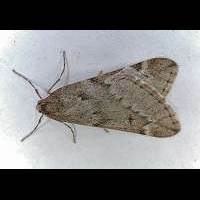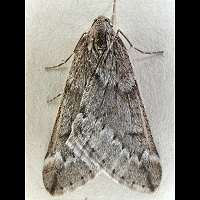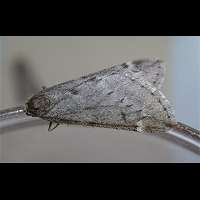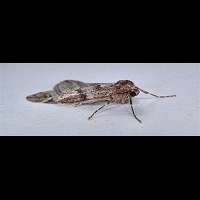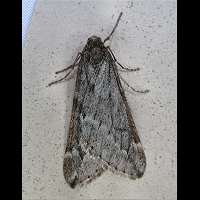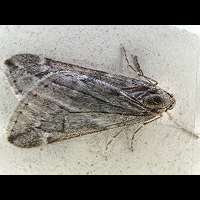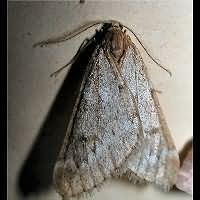[All pictures of garden wildlife on this page are thumbnails. Click on any thumbnail for a large format to be displayed.]

March Moth (Alsophila aescularia)
| Taxonomy | ||||||
|---|---|---|---|---|---|---|
| Kingdom: | Phylum: | Class: | Order: | Family: | Genus: | Species: |
| Animalia | Arthropoda | Insecta | Lepidoptera | Geometridae | Alsophila | A. aescularia |
You can't easily misidentify the March Moth for any other species, but the problem is it doesn't look like a Geometer Worm. Seeing it, it may be looked upon as an overgrown moth. You can tell it is a Geometer by looking at the caterpillar, but usually one isn't at hand. The basic colour of the front wings is silvery grey, but depending on the light it is brownish grey at times. The legs are the same colour but are ringed. Those rings are usually quite white. The antennae look like an eel's spines. The males have a wingspan of 34 to 38 mm, but look smaller the way they usually sit. The females are completely wingless and compared to other wingless females they have a rather short, fat body. At the tale's end there is a tuft of hairs.
There is one generation only, flying about in February, March and April. The flying times are depending on the winter actually. In a cold, harsh winter the first specimens may appear by mid-March, but in very mild winters they may appear as early as January. Going southwards in Europe, they'll fly earlier though. The white eggs are deposited on twigs near developing leaves. They are deposited like a bracelet around the twig and the female covers each egg with some hairs, she pulls out of herself. The eggs hatch quite quickly and we'll see the caterpillars from the beginning of May. The larvae are light green. On top runs a dark green stripe and on the sides run a few whitish or yellowish lines. The caterpillars are very special indeed, for they have the remains of belly legs (the unreal legs seen in larvae of butterflies, moths and saw flies). Those are on the 8th segment only, but are rarely seen in other Geometers. The caterpillar will reach some 28 mm, but may grow a little bigger on the continent. It can be found on numerous shrubs and trees, including apple, plumb, cherry, birch, oak and many others. The March Moth overwinters as a pupa spun in a cocoon.
Of all spring species, by which we mean species that come out of the pupa in spring, this is one of the ealiest. A very common species, sometimes even abundant, in most of England and Wales. In Scotland, Ireland and even the Inner Hebrides this is a very common animal as well. Also in other parts of Europe this is a very common species, quite often even an abundant one. The males are attracted to lights regularly, but the females are extremely hard to find.

© Copyright 1998-2024 gardensafari.net (Hania Berdys)

 English / engels
English / engels  Dutch / nederlands
Dutch / nederlands